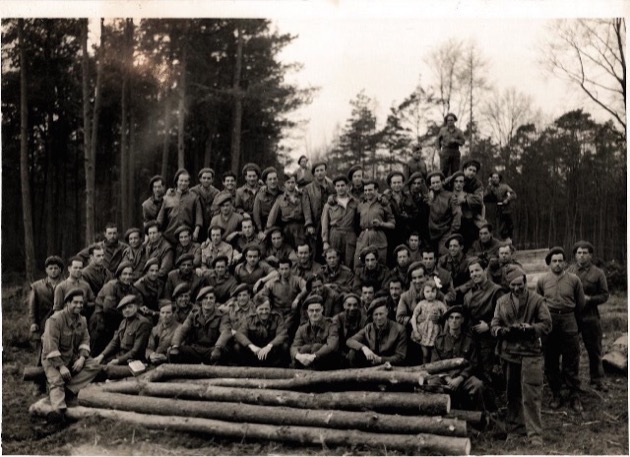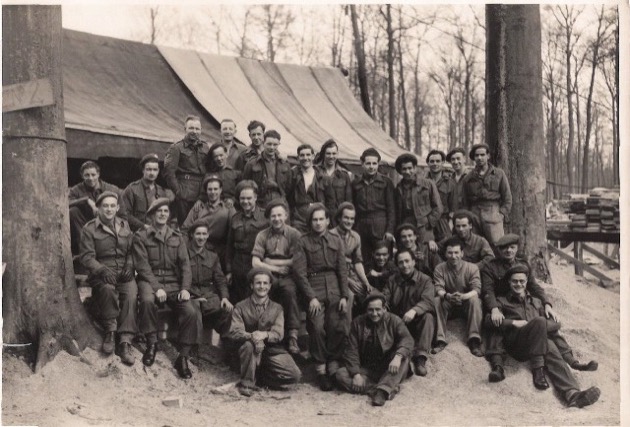The role of Spanish exiles in the Free French forces and the French Resistance has been well documented, but little attention has been paid to those who served in the British army during the Second World War. This gap has now been filled by Séan F. Scullion, a British army officer brought up in Spain, in his book Churchill’s Spaniards: Spanish Republicans who fought in the British Army during the Second World War (Helion & Co, 2024). In research lasting eight years Scullion has traced 1,072 volunteers and has contacted the families of many: their contributions include many of the photos which illustrate this book.
Most of these men had left Spain in early 1939 during La Retirada, the flight from Franco’s army of over 450,000 people from Catalonia into France. Some 250,000 of the exiles had returned to Francoist Spain by early August 1939 and around 15,000 of the remainder emigrated to Latin America in 1939-40. Many of those remaining in France had limited options, especially those who had been active in pro-Republican political parties or in trade unions who faced who faced prosecution and long periods of imprisonment or execution under the repressive legislation enacted by the Franco Regime. Many of the men who stayed in France were recruited by the French government into Foreign Workers Battalions, while some 6,000 joined military units including the Foreign Legion.
With the defeat of France by Nazi Germany in June 1940 some of these men joined the British army. Some were recruited from soldiers who had fought with the Foreign Legion in Norway in May-June 1940, while others were members of a French Labour Battalion which had supported British forces in France. Both groups were in Britain when France fell. Some 300 of them mutinied at Bristol docks in protest at plans to send them back to France. As a result of their protest they were recruited into No. 1 Spanish Company of the Auxiliary Military Pioneer Corps, the only Spanish-speaking unit in the British army.

Until 1944, when this unit was transferred to France, No 1 Company was deployed in Britain constructing defences and carrying out support work. Many of its members, however, would be transferred to other units and would see active service during the conflict. Over 100 underwent training courses for entry to the Special Operations Executive (SOE), members of which were parachuted into occupied Europe to support resistance groups. Scullion has also identified a total of fifteen Spanish members of the Special Air Service (SAS), the elite commando unit and he traces their deployment in France and Italy in the later stages of the war.
A further 75 men recruited in June 1940 came from Spanish Republicans serving in the Foreign Legion in the French colony of Syria: Scullion lists 75 men who crossed into the British colony of Palestine. Most became members of No 50 Middle East Commando, which was sent to Crete in May-June 1941 when it was invaded by German forces. The British were forced to evacuate the island. No 50 Commando covered the evacuation and many members were captured, including 37 Spaniards who would spend the next four years in Prisoner of War camps in Germany. To avoid being deported to Francoist Spain or sent to German concentration camps, they claimed to be British subjects born in Gibraltar. Some, however, managed to escape capture, including Francisco Geronimo, who emerges as one of the most extraordinary figures in Scullion’s account. A native of Malaga and an apprentice electrician in 1936, Geronimo fought at the Ebro in 1938, before joining the French Foreign Legion. After living in the mountains of Crete for 11 months and avoiding German troops, he was rescued and would later join the SAS.
The largest group of Spanish Republicans identified by Scullion was recruited in 1943 in French North Africa (Morocco and Algeria). Some of these had escaped the collapse of Republican Spain in March 1939 on boats, while others had been transferred by the Vichy French government from camps in France. After the allied invasion of North Africa in November 1942, these men were released from harsh labour camps and other forms of detention.

SpanCo-1 – No 1 Spanish Company of the Pioneer Corps. Co. Courtesy of Brian Cole. Previously published on Steven’s Balagan.
Scullion traces the changing tide of the Second World War and its effects on the volunteers. In 1940-41, when the British feared that Spain might enter the war on Hitler’s side or being invaded by the German army, some members of No 1 Spanish Company were trained for infiltration into their homeland. As the war progressed and these dangers receded they were redeployed, which, as Scullion indicates, was a severe blow to their morale. This, of course, was a foretaste of the disappointment they felt in 1945 when the allies left Franco in power.
As Scullion points out, many British officers were initially sceptical of the military value of the new recruits, whether as a reflection of racism or suspicion of their Republican backgrounds. Not surprisingly language would be a problem, even in No 1 Spanish Company. However, it is clear that they soon gained respect for their commitment, experience and abilities. As Scullion states, these were “battle-hardened men who, in some cases, had fought continuously for years.” As veterans of the Spanish Republican army, they were, however, liable, if captured, to be sent either to German concentration camps or to their fate in Franco’s Spain. As well as claiming to have been born in Gibraltar, men, especially members of the SAS, adopted British names.
By 1945, most could justifiably claim to have been fighting fascism for nine years. Afterwards over 500 remained in the UK, taking British citizenship. Francisco Geronimo, for example, married and settled in Cardiff under the name of Frank Williams. Many married British women and the largest contingent settled in London, where the Spanish ex-Servicemen’s Association (founded in 1960) would be based and which would campaign against the Franco regime until the dictator’s death.
The names and ranks of all of the volunteers traced by Scullion are listed in the appendices, along with, in some cases, dates of enlistment, places of origin and previous occupations. Not all, of course, survived the war and Scullion lists the names of 19 Republicans known to have been killed in action, although it must be assumed that the real number is higher. Since the volunteers were dispersed in different units, the book traces their experiences on many different battlefields and abounds with the names and acronyms of military units but these, and other terms, are helpfully listed in a glossary. There is also a detailed chronology covering the period from 1914 to the death of Franco as well as several maps to assist readers who are not experts on the Second World War.
Scullion is aware that more of “Churchill’s Spaniards” remain to be discovered and he clearly regards his work as unfinished. Nevertheless his book provides deserved, although belated, recognition of the contributions of some extraordinary refugees from the Spanish Civil War.
PHOTO: SpanCo-5a – No 1 Spanish Company of the Pioneer Corps. Courtesy of Brian Cole. Previously published on Steven’s Balagan.
NOTE: An earlier version of this article appeared in the January edition of “No Pasarán”, the magazine of the International Brigades Memorial Trust.
